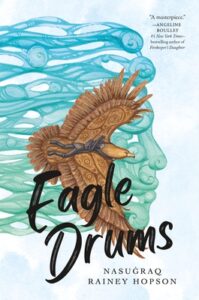For the longest time, Thanksgiving was my favorite holiday. It’s an occasion for people to gather and reflect on all the things they’re thankful for, which is in my opinion the most meaningful reason people can come together. But then, ofc, I learned about the American holiday’s terrible origins in colonization and betrayal, whitewashed over the years to make the day more palatable to larger, more gullible swathes of the populace, amongst whose number I had once been.
 While I’m still grateful for the ability for loved ones to get together and count our blessings, I also think that it’s important for those of us who live here in the United States of America — and by extension Canada — to acknowledge and honor the First People who shared their bounty with others, asking nothing in return (and in far too many cases getting less than nothing, or receiving just outright cruelty or evil in exchange.) So I’m really glad that Nasugraq Rainey Hopson wrote this book, that talks about the origins of the Inupiaq Messenger Feast, a tradition of several native tribes of Alaska that has much in common with the modern celebration of Thanksgiving.
While I’m still grateful for the ability for loved ones to get together and count our blessings, I also think that it’s important for those of us who live here in the United States of America — and by extension Canada — to acknowledge and honor the First People who shared their bounty with others, asking nothing in return (and in far too many cases getting less than nothing, or receiving just outright cruelty or evil in exchange.) So I’m really glad that Nasugraq Rainey Hopson wrote this book, that talks about the origins of the Inupiaq Messenger Feast, a tradition of several native tribes of Alaska that has much in common with the modern celebration of Thanksgiving.
As legend has it, Pinay was the youngest of three brothers who lived with their parents in a rich part of the North. One by one, his older brothers disappeared, leaving him only an ornately carved bow hewn by the eldest and decorated by the middle brother with scenes indicating good hunting. Pinay himself grew to be an expert hunter, honoring the land and working with his parents to store the the food — meat, fish and vegetables — they collected to see out the lean seasons.
But while searching for obsidian one day in the same area where his brothers disappeared, Pinay is accosted by a golden eagle. The eagle gives him a dire warning: follow, or die just like his brothers. And so begins Pinay’s difficult journey to Grandmother Eagle’s aerie, where she and her children teach him song and dance and architecture for reasons they will not explain. The only thing keeping Pinay going is the hope that he’ll one day be reunited with his loved ones. But will he be able to survive in a world of eagles and other creatures decidedly hostile to humans like himself?
The extraordinary middle grade novel that brings this folk tale to meticulous life would be valuable enough on its own for disseminating a tradition suppressed by, you guessed it, colonizers. It also weaves the anthropological details of diet and habitat in and around the Arctic Circle into its narrative, providing fascinating insight into what it takes to survive in such hostile conditions. But Ms Hopson makes Eagle Drums so much more than just a myth or a handbook. She really makes Pinay’s ordeal palpable as he wrestles with his thoughts and feelings, mourning his brothers and longing to see his parents once more. Following along as he ultimately makes excellent, if difficult, choices is a life-affirming experience, one that emphasizes the need for hope and kindness and community even in the face of bleakness and loss — all the things our Thanksgivings ought to celebrate and encourage.
The afterword was also illuminating, as Ms Hopson talks about her background and what compelled her to write (and gorgeously illustrate!) this terrific book. I’m really glad I had a chance to read it over Thanksgiving, and hope you’ll be able to add it to your reading lists, for any time of year, too.
Eagle Drums by Nasugraq Rainey Hopson was published September 12 2023 by Roaring Brook Press and is available from all good booksellers, including
